British Rail Class 165
The British Rail Class 165 Networker is a fleet of suburban diesel multiple units (DMUs), originally specified by and built for the British Rail Thames and Chiltern Division of Network SouthEast. They were built by BREL York Works between 1990 and 1992.[4] An express version was subsequently built in the form of the Class 166 Networker Turbo Express trains. Both classes are now sometimes referred to as "Networker Turbos", a name which was derived some three years later for the project that resulted in the visually similar Class 365 and Class 465 EMUs.
| British Rail Class 165 Networker | |
|---|---|
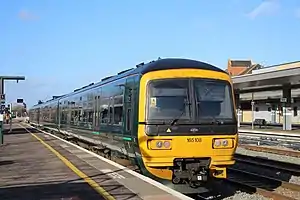 GWR 165108 at Oxford in February 2020 | |
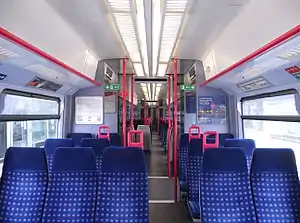 The refreshed interior of a GWR Class 165/1 | |
| In service | 10 September 1991 - present |
| Manufacturer | BREL York |
| Family name | Networker |
| Replaced | |
| Constructed | 1990–1992 |
| Refurbished | 2003–2005 (165/0) |
| Number built | 39 trainsets (165/0) 37 trainsets (165/1) |
| Number scrapped | 1 trainset (due to the Ladbroke Grove Rail Crash) |
| Formation | 2 or 3 cars per trainset |
| Fleet numbers | 165001 - 165039 165101 - 165137 |
| Operator(s) | |
| Line(s) served | Great Western Main Line and branches Chiltern Main Line and branches Severn Beach Line |
| Specifications | |
| Car body construction | Welded aluminium |
| Car length | DMOS/DMOSL - 22.91 m (75 ft 2 in)[1] MOS - 22.72 m (74 ft 6 1⁄2 in)[1] |
| Width | 2.81 m (9 ft 2 5⁄8 in)[1] |
| Height | 3.79 m (12 ft 5 1⁄4 in)[1] |
| Maximum speed | 75 mph (121 km/h) (165/0) 90 mph (145 km/h) (165/1) |
| Weight | 2 Car - 74 tonnes (73 long tons; 82 short tons)[1] 3 Car - 111 tonnes (109 long tons; 122 short tons)[1] |
| Prime mover(s) | One per car, Perkins 2006-TWH[1] |
| Engine type | 14-litre (850 cu in) 6-cylinder turbo-Diesel[1] |
| Cylinder count | 6 |
| Cylinder size | (?) |
| Power output | 350 hp (261 kW) per engine |
| Transmission | Voith Hydraulic T211r 2 axles driven per car |
| Safety system(s) | AWS, TPWS ATP, Tripcock system (165/0) |
| Coupling system | BSI[2] |
| Multiple working | Class 166, Class 168[3] |
| Track gauge | 1,435 mm (4 ft 8 1⁄2 in) standard gauge |
The class is still in service, and is now operated by Great Western Railway and by Chiltern Railways. When operated originally by Network SouthEast, along with that operator's Class 166 trains, the Paddington suburban units were initially known as Thames Turbos, whilst the units operated on the Marylebone suburban network were known as Chiltern Turbos.
Description
Class 165/0
Thirty-nine Class 165/0 Networker trains were built in 1990-91, in two batches, for the Chiltern subdivision of Network SouthEast, numbered 165001-039. Both 2-car and 3-car variants were built. Initially, thirty-three units were ordered (comprising the vehicles that made up units 165001-165022 and 165029-165039) but an additional order was placed for a further six units (165023-028). Units 165001-028 were delivered consecutively, as 2-car units, whilst units 165029-039 were delivered as 3-car units. These vehicles have a top speed of 75 mph (121 km/h). They are now all fitted with tripcocks for working over the London Underground lines between Amersham and Harrow-on-the-Hill, although upon delivery this equipment was only fitted to 165006-028. Automatic Train Protection is also fitted, making them one of the few classes to have both these features in Britain.
Each unit was formed of two outer driving motors, with an additional intermediate motor in the 3-car units. The technical description of the formation is DMOSL+MOS+DMOS. Individual carriages are numbered as follows:[1]
- 58801-58833 (units 165001-022/029-039) and 58873-58878 (units 165023-028) - DMOSL
- 55404-55414 (units 165029-039) - MOS
- 58834-58866 (units 165001-022/029-039) and 58867-58872 (units 165023-028) - DMOS
Class 165/1
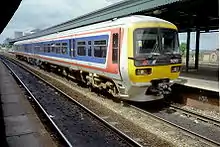
Thirty-seven Class 165/1 Networker trains were built in 1992 for the Thames line subdivision of Network SouthEast, numbered 165101-137. Like the Chiltern units, both 2-car and 3-car variants were built. Units 165101-117 were delivered as 3-car units, followed by the 2-car units 165118-137. They are re-geared and fitted with bogie yaw dampers to allow top speed of 90 mph (145 km/h), more suitable for mainline use.
Each unit was formed of two outer driving motors, with an additional intermediate motor in the 3-car units. The technical description of the formation is DMOCL+MOS+DMOS. Although still listed on the vehicle data sheets at DMCL vehicles, the first class area has been removed from 2-car 165s operated by GWR. As such these vehicles are now technically DMOSL vehicles. The 3-car units were similarly de-classified, but the first class accommodation has now been re-instated on these. Individual carriages are numbered as follows:[1]
- 58953-58969 - DMCL
- 58879-58898 - DMOSL changed from DMCL in 2015[5]
- 55415-55431 - MOS
- 58916-58932 and 58933-58952 - DMOS
Two coaches of no. 165115 were destroyed in the Ladbroke Grove rail crash. The remaining driving motor carriage remains as a spare vehicle.[6][7]
Accidents and incidents
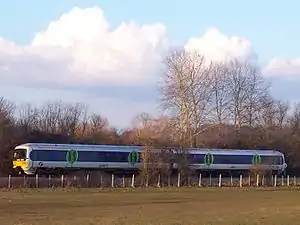
- 165128 was in service as a hybrid unit with 58609 (MOS vehicle from 166209) inserted in the middle from November 2015 until May 2016, this was due to one of its driving vehicles having fire damage from an engine fire on the North Downs line in November 2015, rendering it out of service, and so to provide another 3-car train in service.[8][9]
- On 16 June 2016, unit 165124 was derailed by a set of trap points at Paddington after passing a signal at danger, causing significant disruption to services. The Drivers assistant side of the cab was destroyed after the train hit a stanchion that holds up the overhead catenary after derailing. The vehicle was moved after 2 days in position at Paddington to Old Oak Common Depot to be taken away by road for Assessment and repair work.[10]
- Ladbroke Grove rail crash: On 5 October 1999, unit 165115 passed a signal at danger while leaving London Paddington on a Thames Trains service. This resulted in a serious collision with a London-bound HST service. 31 people were killed and 417 were injured. The leading carriage of the Class 165 was completely destroyed. While the front two carriages were written off, the rear carriage was undamaged and is now a spare carriage.
Operations
Chiltern Railways
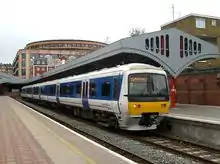
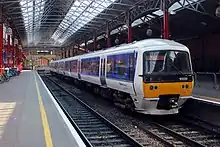
The 165/0 units were originally delivered in Network SouthEast livery for used on routes including fast services from London Marylebone to Princes Risborough and Banbury and local services from Aylesbury to London and Princes Risborough. In this role they replaced the Class 115 DMUs. They were later used further afield, when Chiltern services were extended to serve Leamington Spa, Solihull and Birmingham Snow Hill.
In December 1993, due to a downturn in traffic as a result of the recession, units 165001-007 were transferred from the Chiltern lines of Network SouthEast to the Thames lines (from Aylesbury to Reading depots). All vehicles had their tripcock equipment removed before transfer. The following year, unit 165007 was returned to the Chiltern lines, followed by 165006 in 1995. Due to unavailability of tripcock equipment upon their return, the units were coupled cab-to-cab and operated for some months between the vehicles of other units as semi-permanently formed four car units - until tripcock equipment became available, allowing them to be restored to operational two car units. Following privatisation, two former Chiltern units (165003 and 165005) were repainted into Thames Trains livery. Chiltern Railways inherited 34 Class 165/0 units from Network SouthEast, and the remaining five others were returned from Thames Trains in 2004 - leaving Chiltern Railways operating the whole subclass.
After privatisation they continued to work similar services as before but, with the arrival of the faster Class 168 Clubman units, the 165 Turbo trains were displaced and are now found less often on expresses to Birmingham, generally working on shorter routes such as stopping services to Aylesbury, High Wycombe, and Stratford-upon-Avon and also the Birmingham Moor Street - Leamington Spa local services.
A new depot was built at Aylesbury in 1990/1991 for the maintenance of these trains and has been enlarged since British Rail days, with the addition of a wheel lathe. Light maintenance and refuelling is carried out at Wembley LMD and Tyseley TMD and units can occasionally be found at Stourbridge LMD. Units are also regularly stabled in the Marylebone station environs, Aylesbury South Sidings and at Banbury, where a further depot is currently under construction at the south end of the station on the western side of the line.
All Chiltern units were refurbished between late 2003 and early 2005.[4] Air conditioning was added and the opening hopper windows replaced with sealed units. A new passenger information system, similar to that on the Class 168 Clubman trains, CCTV cameras and an area designated for the use of wheelchair-users were added and the first-class section was removed, as Chiltern became a standard-class only railway in 2003. The original 3+2 seating at the outer ends of the driving vehicles was replaced by new 2+2 high back seating. The existing 3+2 low back seating was retained in the centre areas of the driving vehicles and throughout the centre vehicles of the three-car units. A cycle/wheelchair area with tip up seats was also added to each unit. A further refurbishment commenced in 2015, concentrating on the toilet areas, to make these units fully Disability Discrimination Act 1995 (DDA) compliant for operation beyond 2020.
They can often be found on the Aylesbury to London Marylebone routes including the Princes Risborough shuttle.
Thames Valley

The Class 165/1 fleet were built for local services from London Paddington along the Great Western Main Line; their main destinations included local trains to Reading, Greenford, Newbury, Bedwyn, Oxford, and Banbury, and services along the branch lines to Windsor & Eton Central, Henley-on-Thames, Marlow and Bicester Town.
Following privatisation of British Rail, the franchise was won by the Go-Ahead Group who operated it as Thames Trains from 1996 to 2004 and inheriting the all the Class 165/1 Turbo trains as well as the first five Class 165/0 Turbo trains that had been transferred from the Chiltern lines. In April 2004, operation of the Thames Trains franchise passed to First Great Western Link. In 2004, due to deliveries of new Class 180 Adelante units on sister company First Great Western, the five Class 165/0 Turbo units became redundant and were transferred to Chiltern Railways.
In January 2010, First Great Western announced an £8 million refurbishment programme for its fleet of Classes 165 and 166 Turbo DMU trains:[11]
- seats re-trimmed
- interiors repainted
- Passenger Information Displays replaced with a GPS-based system
- upgraded lavatory facilities
- flooring stripped and replaced
In 2012, First Great Western took delivery of Class 180 Adelante units for Cotswold Line service, and three-car Class 150 Sprinter units for Reading to Basingstoke Line services, allowing Class 165 and 166 units to be used to reinforce Thames Valley services.[12]
In late 2015, as part of the rebranding to GWR, the Class 165 fleet had all first class sections removed to increase capacity.[13]
Following electrification of the Great Western Main Line up to Didcot Parkway, as well as the Reading-Taunton line as far as Newbury, services between London Paddington and Didcot Parkway, as well as between Reading and Newbury, have been operated by new Class 387 electric multiple units,[14] allowing much of the existing Class 165 fleet to move to the Bristol area. Class 165s continue to service the aforementioned branch lines, but no longer run to London Paddington except during peak hours.
Bristol area
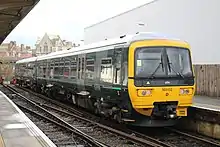
Alongside the Class 166s, some of the Class 165 fleet has been transferred to Bristol and allocated to St Philip's Marsh depot. This is to be able to strengthen and provide better capacity in the Bristol area, allowing most of the fleet in the Bristol area to move further west.[15] One of the main purposes for the Class 165 operation in the Bristol area is for them to be coupled up to Class 166s for the Cardiff Central to Portsmouth Harbour service, which means the service will be provided by a 5 coach train.[16]
Current fleet details
| Class | Operator | No. Built | Year Built | Cars per Set | Unit nos. | Notes |
|---|---|---|---|---|---|---|
| 165/0 | Chiltern Railways | 28 | 1990-1 | 2 | 165001 - 028 | |
| 11 | 3 | 165029 - 039 | ||||
| 165/1 | Great Western Railway | 16 | 1992 | 3 | 165101 - 114 165116 - 117 |
165115 destroyed in Ladbroke Grove rail crash |
| 20 | 2 | 165118 - 137 |
Future development
It was reported in September 2018 that Angel Trains were to convert class 165 units for Chiltern Railways to hybrid diesel and battery-powered trains, and that the first Class 165 HyDrive train should be ready by mid 2020.[17]
In April 2020, unit 165004 was sent to LORAM rail at Derby for HyDrive conversion.[18]
Gallery
 Chiltern Railways three car Class 165/0 No. 165034 at London Maylebone
Chiltern Railways three car Class 165/0 No. 165034 at London Maylebone The refurbished interior of the MOS vehicle aboard a three car Chiltern Railways Class 165/0
The refurbished interior of the MOS vehicle aboard a three car Chiltern Railways Class 165/0 First Great Western two car Class 165/1 No. 165134 at London Paddington
First Great Western two car Class 165/1 No. 165134 at London Paddington The refurbished interior of Standard Class aboard a two car First Great Western Class 165/1
The refurbished interior of Standard Class aboard a two car First Great Western Class 165/1 First Great Western three car Class 165/1 No. 165108 at London Paddington
First Great Western three car Class 165/1 No. 165108 at London Paddington The refurbished interior of the First Class cabin aboard a First Great Western Class 165/1
The refurbished interior of the First Class cabin aboard a First Great Western Class 165/1 The refurbished interior of Standard Class aboard the MSO vehicle aboard a three car First Great Western Class 165/1
The refurbished interior of Standard Class aboard the MSO vehicle aboard a three car First Great Western Class 165/1
References
- Colin J Marsden. "Technical Data: Class 165". Retrieved 17 March 2010.
- "Mechanical And Electrical Coupling Index". Rail Safety and Standards Board. Archived from the original on 21 December 2013. Retrieved 20 December 2010.
- Webster, Neil; Hall, Peter; Fox, Peter (2001). British Railways Locomotives & Coaching Stock 2001. Sheffield: Platform 5 Publishing. pp. 207, 208. ISBN 1-902336-19-4.
- "Chiltern Railways: About us - Our train fleet". Chiltern Railways. Archived from the original on 3 July 2010. Retrieved 26 August 2008.
- "First Great Western gets rid of First Class on Reading trains".
- "Thames Trains fined £2m for Ladbroke Grove crash". The Daily Telegraph. London. 5 April 2004. Retrieved 27 April 2010.
- Chapple, James (16 November 2015). "Passengers 'standing around in country lane' after train fire".
- "165128 at Didcot Parkway on 2N52 1625 London Paddington - Oxford with an additional vehicle 041215 (8)".
- "Train derails at Paddington: Services disrupted in and out of station". BBC News Online. 16 June 2016. Retrieved 17 June 2016.
- First Great Western - Train operator gives Thames Valley Trains an £8million makeover Archived 11 June 2011 at the Wayback Machine
- "Return of Adelantes to First Great Western confirmed". Railnews.co.uk. 23 November 2011. Retrieved 23 November 2011.
- "First Great Western gets rid of First Class on Reading trains". Rail. 8 September 2015. Retrieved 7 February 2016.
- https://www.newburytoday.co.uk/news/home/26259/more-train-seats-for-commuters-from-wednesday.html
- Holden, Alan (5 October 2019). "New timetable for South Wales launched by Great Western Railway". RailAdvent. Retrieved 13 February 2020.
- "Hybrid battery trains set to shorten commuter journey times". FT. Retrieved 19 September 2018.
- "Rail - '165' at Derby for hybrid conversion". www.pressreader.com. 6 June 2020. Retrieved 8 June 2020.
Further reading
| Wikimedia Commons has media related to British Rail Class 165. |